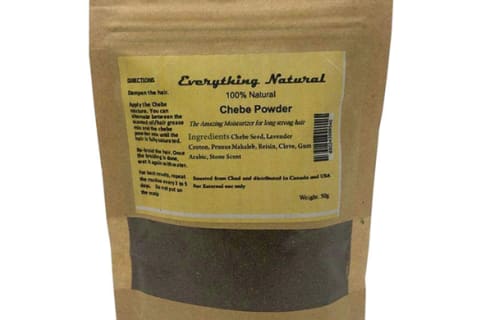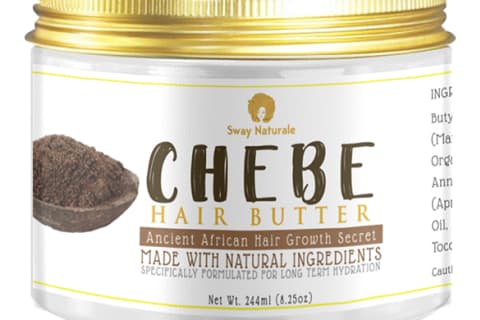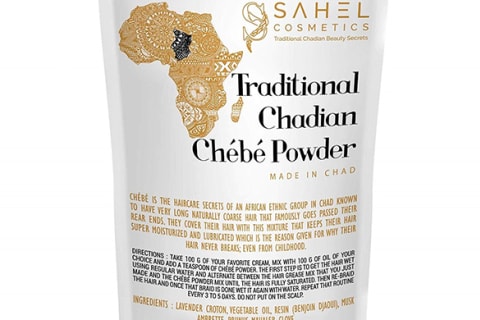Advertisement
Chebe Powder For Hair: Benefits, Best Products & How To Apply It Correctly

Chebe powder is a hair moisturizer of the highest order: When it comes to protecting and conditioning thirsty strands prone to breakage, few ingredients deserve more honorable mention. It has a long history of use and is even touted for hair growth—so let's dive right into it, shall we?
Ahead, find everything you need to know about chebe powder: the history, the benefits, and how to use it correctly.
What is chebe powder?
Chebe powder is an all-natural powder mixture originating from a tribe in the Chad Republic in Africa. It has been used for centuries and is beloved for hair growth: In fact, one Google search will leave you with plenty of photos of women in Chad with hair down to their waists—all thanks to the lubricating properties of this powerhouse powder.
As for what comprises the powder itself? "It's not a single ingredient—it's actually a mix of ingredients," says chemist Christine Martey-Ochola, Ph.D., co-founder of NUELE. Specifically, the powder will contain some combination of croton, mahllaba, cloves, and missic (to give it a nice aroma). Seeds from each plant are harvested, dried, and then ground into a fine powder you can use as a base for leave-ins and hair masks.
Benefits for hair.
Let's break down the powder's impressive résumé:
Helps hair retain length.
"The powder itself doesn't make your hair grow; however, the benefits and properties it has do," says texture specialist Michelle O'Connor, global artistic director at Matrix. Read: The powder won't actually stimulate the follicles and cause hair growth, but its moisturizing abilities help the hair you already have stay healthy and strong (and healthy hair tends to grow longer and faster).
Locks in moisture.
Generally, you would mix chebe powder with a carrier oil before applying to the hair (don't worry; we offer a tutorial down below), which seals in moisture and delivers fatty acids and antioxidants to the strands. But "the seeds that are used also have different types of oils in them," says Martey-Ochola. "They have an emollient, conditioning activity to them that will allow the hair to maintain its integrity from a moisturization perspective."
Reduces breakage.
According to Martey-Ochola, the fine powder can "fill in" the spaces on the hair shaft—meaning, it helps seal down the cuticle. This not only helps trap in water nutrients (leaving hair conditioned and moisturized), but a closed, lubricated cuticle also means less friction between the strands. In turn, this also means less breakage: "[The strand] becomes a little stiffer and doesn't break as easily," she notes.
Mildly exfoliates the scalp.
Depending on how you use it, chebe powder can exfoliate the scalp—the powder has a gentle, grainy texture, so you could use those granules in a DIY scalp scrub. "That allows for a refreshing feeling on the scalp," says Martey-Ochola. She also notes that cloves have some naturally astringent properties that could help balance oil on the scalp as well—some research also touts cloves' ability to relieve itch1.
We should note that if you do use chebe powder on the scalp, you'll want to thoroughly rinse it out after scrubbing—you don't want to let it build up on the follicles.
Keeps hair color vibrant.
As a general rule, healthy, moisturized hair tends to hold on to color for longer. "Healthy hair is better at maintaining the strength of color production." She also notes that chebe powder may contain natural dyes that can help duller strands appear more vibrant—there isn't much research on that front, but you might want to keep it from staining your clothing if you use it.
Who should use it?
"[Chebe powder] is most well-suited for hair that has a harder time retaining moisture and/or length," says O'Connor. "This generally falls under the hair type 3s and 4s." (In case you don't know how to I.D. your hair type, see here for our quick quiz.)
The mixture is super thick and clings to the strands, which is why Martey-Ochola suggests skipping the product if you have fine, fragile locks: "If someone has hair that is very thin or they have follicles that are not very strong, it can [potentially] lead to loss of hair," she says. "It's really important to think about your hair texture."
How to use it.
Whether you concoct your own DIY mixture with the powder or find a buttery, chebe cream for easy application (our recs, below), here's how to use it correctly:
As a leave-in.
For protective styles, chebe powder makes a fabulous leave-in. Follow O'Connor's tutorial below:
- Shampoo and condition your hair as usual.
- "Apply your favorite oil or pomade, and spread the powder over the hair," says O'Connor. After working the oil and chebe powder through the strands, braid or twist the hair.
- Leave it for about three days, then reapply the oil-chebe powder mixture directly onto your braids or twists. "The previous treatment should not be washed out. You apply over it," says O'Connor.
- Repeat until your next wash day—just remember to only apply on the lengths of your hair, not on your scalp.
As a hair mask.
To make a conditioning hair mask, here's what Martey-Ochola suggests:
- Mix the chebe powder with water and a lightweight oil, like olive oil or jojoba oil.
- Cover with a cap and leave it on for several minutes.
- Wash thoroughly with lukewarm water. "Not very hot water and not cold water either," says Martey-Ochola. The washout is important, especially if you're applying at the roots: You don't want the heavy mixture to linger on the scalp.
- Shampoo, condition, and style as usual.
As a scrub.
Given its sandy texture, you can use the powder as a scrub, if you choose:
- Mix the chebe powder with a lightweight oil until well combined.
- Take a dollop of the mixture and rub it onto the scalp in sections. Gently massage—you don't want to rub too harshly, says Martey-Ochola.
- Thoroughly rinse with lukewarm water before shampooing. The rinse is even more important here, as you don't want to suffocate your follicles with the thick mixture.
Our recommendations.
Warnings & risks.
Chebe powder has a laundry list of wonderful moisturizing and strengthening properties—just make sure you use it correctly. Says O'Connor, "It's recommended to apply it to the mid-shaft and ends, as it could possibly clog the pores on the scalp." We repeat: If you apply chebe powder on your roots or use it as a scrub, make sure to thoroughly rinse when you're done.
Other than that, it's generally safe to use on the hair; although, you might want to patch-test before applying to make sure you don't have any allergies or sensitivities to the ingredients.
The takeaway.
Chebe powder is revered for keeping textured hair strong and healthy (which, in turn, can help it retain length). Just make sure you're using it correctly, and it should happily moisturize thirsty strands.


